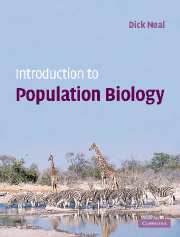Book contents
- Frontmatter
- Contents
- Preface
- Acknowledgements
- PART I Evolution by natural selection
- PART II Simple population growth models and their simulation
- PART III Population genetics and evolution
- PART IV Demography
- PART V Interactions between species, and the behaviour of individuals
- Glossary
- Solutions to problems
- References
- Index
PART V - Interactions between species, and the behaviour of individuals
- Frontmatter
- Contents
- Preface
- Acknowledgements
- PART I Evolution by natural selection
- PART II Simple population growth models and their simulation
- PART III Population genetics and evolution
- PART IV Demography
- PART V Interactions between species, and the behaviour of individuals
- Glossary
- Solutions to problems
- References
- Index
Summary
In this last section of the book, we consider two different aspects of population biology. First, we examine some aspects of the interactions between different species. There are many ways in which species interact – symbiosis, commensalism, competition, predation, etc. – but we will only consider competition (Chapter 17) and predation (Chapter 18) because of space limitations. These two types of interactions have a very powerful effect on what Darwin termed ‘the struggle for existence’. Thus, it is likely that these two processes apply powerful selective forces on the characteristics of organisms. It will also be observed that in many cases, the behaviour of individuals plays an important role in these interactions.
Behaviour is considered in Chapters 19 and 20, and we return to some of the issues that Darwin raised in the fourth and seventh chapters of his book, The Origin of Species. After discussing the genetic basis of behaviour at the start of Chapter 19, the problem of altruistic behaviour is considered. In this type of behaviour, some individuals appear to reduce their fitness to help other individuals, and the most extreme example of this is the existence of sterile castes in insects. This type of behaviour appears contrary to the theory of natural selection, which states that only those traits that improve the fitness of an individual can evolve in populations.
- Type
- Chapter
- Information
- Introduction to Population Biology , pp. 263 - 264Publisher: Cambridge University PressPrint publication year: 2003



